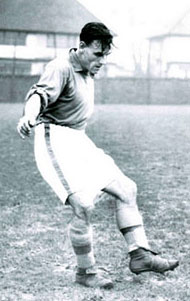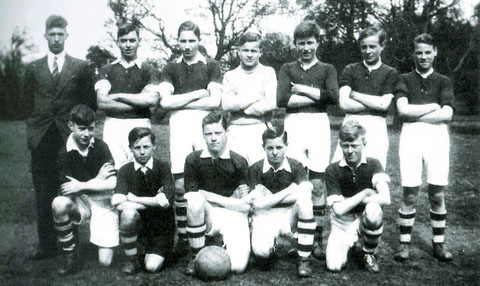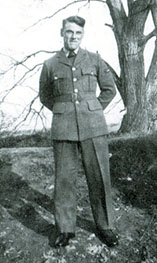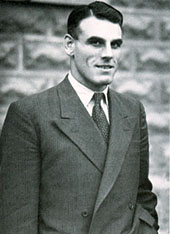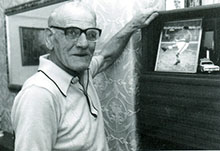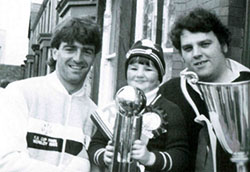Article on the eponymous Cyril Lello. Interesting to note that ex employees lived in Goodison Rd. and left their house at 2.55 to watch the match starting at three o'clock.
 http://toffeeweb.com/season/13-14/comment/editorial/27560.html
Everton's Shropshire Lad - The Cyril Lello Story
http://toffeeweb.com/season/13-14/comment/editorial/27560.html
Everton's Shropshire Lad - The Cyril Lello Story
Ludlow, now the gastronomic capital of the beautiful county of Shropshire, is a football backwater... yet even 60 years after his heyday, Cyril Lello is still held in affection in the market town. In Everton’s dark days of the early 1950s, with the team struggling to return to the top flight of English football, it was the Salopian, a quiet man with matinee idol looks, who brought authority – and no little ability – to the Blues cause.
The road to Goodison Park was a long one: Cyril Frank Lello came into the world on 24 February 1920, not long after his father Thomas returned from the Great War in Flanders and France. He grew up alongside his five siblings in the idyllic setting of Ludlow’s Dinham Mill on the banks of the River Tene as Thomas worked for the hydro-electricity generating company.
Football became Cyril’s all-consuming passion as playing opportunities sprung up through senior school, the Boys Brigade and the wonderfully named ‘Try Hards’ – the latter alongside his brother Harold. By his teens, when working for a local greengrocer, he became the centre-forward in The Early Closers – a team which, in the days of half-day shop closing, played during the afternoon in the Ludlow Thursday League.
By the age of 17 he was playing at centre-forward for Ludford Amateurs and impressed enough to be offered a short-lived trial with Hereford United. From there it was on to Ludlow Town and, from 1938, Shrewsbury Town where he appeared for the reserves as an amateur.
The outbreak of the Second World War saw Cyril briefly appear, for Shrewsbury and Hereford before – with a Nazi invasion of the UK a real prospect – he enlisted in the RAF in June 1940. Having joined as a Ground Gunner Cyril rose to Leading Aircraftman – trained in using weapons to defend military airfields, principally in the east of England. After several appearances for Norwich City he was billeted to Northern Ireland where he would make an impression for Derry City, scoring 20 goals in the 1942-43 season. Back on the mainland in late 1943, he became a regular for Lincoln City, notably scoring seven of the Sincil Bank team’s goals in an 8-5 victory over Notts County.
The Try Hards featuring Harold and Cyril Lello circa 1934
After a couple of appearances for Millwall towards the end of the War, Cyril was transferred to Germany where he played for RAF sides against the Army. Upon being de-mobbed in the summer of 1946, Cyril picked up his football career at Gay Meadow with Shrewsbury Town, then of the Midland League. He would commute to matches and training from his parents’ home in Ludlow and, in the summer, worked as an assistant groundsman for the football club.
Cyril in the RAF circa 1942
Cyril's rapid progress in his one full season as a professional at Shrewsbury was being monitored. In October 1946, after a scouting trip, Everton board member W R Williams reported that he had a “first class opinion of this centre-forward”. Cryil was described, erroneously, in the board minutes as 24 years old (he was 26) and 5-ft 8-in tall. After two further scouting missions, Everton made enquiries about negotiating a transfer in January 1948 but Shrewsbury were in no mood to do business.
After continuing to have Cyril watched, on 12 August 1948 the Everton board sanctioned W R Williams to negotiate with Shrewsbury up to a ceiling set at £4,000. After a period of haggling, a fee of £2,500 was agreed for the player, who was now primarily an inside-left (attacking left-midfielder) or a left half-back (deep lying left-sided midfielder).
The deal came as a shock to Cyril; he was bundled into a car with Shrewsbury’s secretary and only told of his destination as the vehicle sped towards Merseyside. His weekly wages were set at £7 during the season and £6 in the summer. On his debut for Everton’s reserves, Cyril scored one and set up two for the centre-forward, Harry Catterick.
Cyril Lello "demobbed" in 1946
His first team bow would come in February 1948, appropriately at Wolves’ Molineux ground – the only top-flight stadium he had watched a game at prior to his transfer to Everton. ‘Pilot’ in the Evening Expressed purred over the debutant:
“The whole attack moved with rhythm and purpose. Lello – making his debut – was an immediate success. This boy is a find.”
‘Stork’ in the
Daily Post was equally impressed: “Newcomer Lello justified all the good things I have heard about him. He has sound ball control, was clever in his passing and was always up flicking the ball, this way and that, in the style of a real artist.” Herbert Powell, Secretary of the Football Association of Wales, was watching the match; knowing that Lello came from Shrewsbury Town he had hoped that he hailed from the Welsh side of the border – he was disappointed when Everton’s Secretary-Manager, Theo Kelly, put him straight.
A home debut a week later also drew rave reviews with some reporters drooling over ‘young Lello’. It has been suggested that Theo Kelly had deliberately played down the fact that the new signing was by now twenty-eight but perhaps Everton remained under the misapprehension, based on that first scouting report in 1946, that Cyril was two years younger than he actually was.
Under Cliff Britton, who succeeded Kelly as Manager in October 1948, Cyril became a regular in the Number 6 shirt, working in tandem with Peter Farrell on the left flank. The half-back was admired for his physicality, 90-minute fitness and powerful shot.
By his own admission, Cyril was not the most talented player in the land, former coach Gordon Watson recalled humorously to David France: “He was over-reliant on biting tackles and timely interceptions – the latter was a technique he almost got the hang of.” With talk of an international call up in the press, progress came to a juddering halt when Cyril suffered a severe knee injury in February 1950 at Villa Park stork football echo. In an era before substitutes he hobbled on for ten minutes before admitting defeat.
The injury was described as a “bad bruise on the back of the knee” and it was expected that Cyril would resume training in time to be fit for the following week’s cup tie against Spurs. However the Evening Express on 9 February reported “Cyril Lello remains doubtful with a strained tendon at the back of a knee. It is hoped that Lello would be able to train today but manager Britton will not risk it – for a return to work too early could upset the good work which has been done in four days of constant treatment."
The Everton team circa 1950
The comeback kept getting put back and in mid-March – with an FA Cup semi-final approaching – Cyril, along with other injured parties including Harry Catterick, was packed off to Buxton to receive special treatment at the Derbyshire spa town. He would finally would return to first team action in April, too late for the cup tie, but the ailment had not been cured.
Once the season ended, the troublesome knee went under the surgeon’s knife. Cyril recalled to the Everton matchday programme in 1970: “That was one of the biggest disappointments of my career. I eventually had to have a cartilage operation. After this, I had to go for special treatment at Patshull near Wolverhampton.”
Missing the entire 1950-51 season, his authority and strength on the pitch was sorely missed. The club was on an inexorable slide from the heights of 1939 and Cyril was a frustrated onlooker as his club-mates slipped to the ignominy of relegation.
Whilst out of football action in 1950, Cyril married Elsie Healey, a Kirkdale girl who worked for Vernons Pools company. Their only child, Cyril Francis was born four years later. Cyril Junior recalls the celebrity that Cyril enjoyed, despite not being a big socialiser: “He couldn’t go more than five yards without anyone saying ’Hello’ – my mother wouldn’t go out with him in the end as she couldn’t get any shopping done!”
The Lellos were fortunate to be given the keys to 24 Goodison Avenue, a club house formerly occupied by Theo Kelly. Most of the houses on the street were occupied by club employees including trainer Harry Cooke and team-mate Tommy Clinton who lived three doors down at Number 18.
Although back in the team as Everton started life in the Second Division, Cyril he was unable to reach the requisite level for concerted action and dropped back into the Reserves until January 1952. Coming back from major knee surgery in his early thirties – the age when many players were winding down their careers – was a testament to the dedication of the man. His return to action, in a 3-0 victory against Cardiff on 19 January, was hailed by the Evening Express: “Everton made a master move in the switch of Peter Farrell to right-half and the re-introduction of Cyril Lello. It was one of the main factors in this return to form. Lello emphasised that there was wisdom in giving himself plenty of time to play himself back into the game after his serious injury.”
Within a few weeks of his first-team comeback, ‘Radar’ in the Evening Express proclaimed: “We saw Cyril right back to his best form of two seasons back. He was faster, stronger in the tackle and invariably using the ball to advantage. Everton have no fear regarding the left half berth while Lello continues in this standard.” In March of that season, when Everton hosted Swansea, Cyril was credited with being the first Everton player to score for both his own team and the opposition. Fortunately his goal at the ‘right’ end was the winner in a 2-1 victory.
Promotion back to the top flight is secured in 1954
Despite his veteran status Cyril’s importance to the squad deepened during the push for promotion back to the top flight; he became the first Everton player to make 150 consecutive league and cup appearances. He was an ever-present in 155 fixtures between December 1952 and March 1956 during which time Everton had scraped back into the First Division in April 1954. Teammate Jimmy Harris recalls: “Cyril was a very reliable, steady, he didn’t have many bad games at all. He was very quiet, but witty, and a very good player.”
Cyril recalled in 1970: “I could not have picked a better team. The atmosphere among the players was terrific. There were no small cliques as you might find at other clubs and Peter Farrell was a great skipper and a tremendous organiser. I could sum it up as ‘One for all – all for one!’”
Perhaps Cyril’s finest hour was in February 1955 when he foiled the famous ‘Revie Plan’ in a 1-0 victory over Manchester City. The future Leeds United manager was the fulcrum of the revolutionary City side – despite being a forward, Revie would come deep to receive the ball and distribute it to the other four forwards. Cyril stuck to Revie like glue: “I was given the job of picking up Revie and I nearly always had a good game against him. It gave me great satisfaction to know that I’d done a professional job.” The press hailed Cyril the next day with headlines including: “Lello put kybosh on Revie Plan”.
Harry Cooke and Cyril Lello circa 1955
The arrival of Ian Buchan as Head Coach in the summer of 1956 signalled the beginning of the end of Cyril’s Goodison career. He was dropped five games into the 1956-57 season before making what would be his final appearance, wearing the Number 10 inside left shirt on 8 September 1956. That 4-0 defeat to Aston Villa was his 254th Everton appearance; he had scored nine goals.
In November, 1956, Rochdale took Cyril to the Third Division North, where he was re-united with former team-mate Harry Catterick – now an ambitious young manager. On his departure for Spotland, Everton’s Captain Peter Farrell described Cyril as “one of the finest club men ever to wear the blue jersey.” Cyril, at 36, would play in a variety of positions for Rochdale: inside-forward, half-back, full-back and even, on one occasion, stand-in goalkeeper.
In fact, Cyril had not completely left Everton behind: he was permitted to continue living on Goodison Avenue and much of his training routine was undertaken at Bellefield in order to minimise commuting. Come the end of the season, he returned closer to home, as player-manager of the Cheshire League’s Runcorn AFC – he would remain at Canal Street for four years.
Runcorn AFC circa 1958; New Brighton FC in 1961
When he left ‘The Linnets’ in 1961, he was still playing, generally as a centre-half, at the grand footballing age of 41. He would switch to New Brighton as player-coach, here he would pull on his boots for the last few times before a slipped disc forced his retirement from playing. Leaving football, he would spend the next 24 years working for Lee Beesley, an electrical contractor based in Penny Lane.
In 1969 Cyril’s wife, Elsie, passed-away at just 45 years of age after suffering with jaundice. He continued to live on Goodison Avenue with Cyril Junior – later joined by his son’s wife and their two children. He attended nearly every home game at Goodison Park – only having to leave the house at 2:55 pm to be seated in time for kick-off; he greatly enjoyed watching Harry Catterick and Howard Kendall lead Everton to glory in the 1960s and 1980s. Players such as Alex Young and Brian Harris would regularly call by his house for a cup of tea.
Cyril Junior recalls Harris, ever the practical-joker, being up to his usual tricks: “I remember Brian sending me out to get ‘pockets of steam’ – and I went as well!” Cyril Junior would enjoy kick-abouts with players in Goodison Avenue, as recently as the 1980s with the likes of Kevin Sheedy.
Cyril would make occasional return visits to family and friends in Ludlow – always being assured of a hero’s welcome, as his son recalls: “You couldn’t go out in Ludlow with him. We went down for the summer holidays and everyone talked to him – it took an hour to get 10 yards. He would talk to somebody and then walk away and I’d ask ‘Who was that Dad?’ and he’d say: ‘I don’t know.’ He spoke to anybody, he was that sort of person, they knew his face but he hardly knew of any them."
Cyril and 1940s friends reunited in 1995
In 1995, Cyril was reunited with former teammates at a function in Goodison Park to mark the opening of the new Park End stand. Amongst those assembled were Dave Hickson, Ted Sagar and Tommy Clinton; later that night he suffered a major stroke. Having lost mobility on the left side of his body he moved to live in a nearby nursing home.
This would not stop the Evertonian of 40 years attending home matches until just before his death on 16 August 1997. In 1996, Cyril’s family was obliged to move out of Goodison Avenue as the area was being redeveloped and the houses required demolition – the severing of a link to an era when employees of the club would live, literally, across the street from their place of work.
Cyril Junior, who had been attending every home game from the age of five until his father passed away, could no longer face going to matches: “It wasn’t the same after that – I tried it once and didn’t go again.”
Kevin Ratcliffe with Cyril Lellos' son and grandson on Goodison Avenue in 1985
Cyril’s reputation in his home town has hardly been eroded with the passing years. In 2001, an event called “Local Heroes of the Beautiful Game” was held in Ludlow to celebrate football in the town and to launch Cyril’s posthumous biography, written by Barbara Ridgway:
From Dinham Mill to Goodison – The Story of Cyril Lello: a Craftsman Footballer. Crowds flocked to the exhibition and a new generation learned about Everton’s Shropshire lad.
Acknowledgements
My thanks to the following for making this article possible:
Barbara Ridgway
Cyril and James Lello
Jimmy Harris
James Corbett (Everton Encyclopaedia)
Billy Smith (Blue Correspondent Website)
Photographs from the Lello family collection courtesy of Barbara Ridgway

